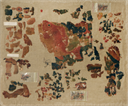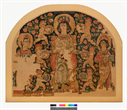Bibliography
P. Ackerman. "An Unique VIth or VIIth Century Coptic Tapestry." The Art News, Nov. 13 1926, 1.
Exposition internationale d'art Byzantin, exhibition catalogue, Musée des Arts Décoratifs, Palais du Louvre, 28 May-9 July, 1931, (Paris, 1931), 92, no. 190, fig., 7.
W. F. Volbach, “Die byzantinische Ausstellung in Paris,” Zeitschrift für bildende Kunst 65 (1931–32): 102–113, illustration p. 109.
G. Hanotaux, Histoire de la nation égyptienne (Paris, 1931-), pl. 481, (reproduction only).
H. Peirce, and R. Tyler, L'Art Byzantin (Paris, 1932-34), 91-92, fig. 153-154.
P. Ackerman, Tapestry, the Mirror of Civilization (New York, 1933), 20-21, fig. 3.
W. F. Volbach, G. Duthuit, and G. Salles, Art byzantin (Paris, 1933), 73, fig. 84-84.
D. Talbot Rice, Byzantine Art (Oxford, 1935), 178.
L. Bréhier, La sculpture et les arts mineurs byzantins (Paris, 1936), 96-97, fig. 79.
The Dark Ages; Loan Exhibition of Pagan and Christian Art in the Latin West and Byzantine East, exhibition catalogue, Worcester Art Museum, February 20-March 21, 1937, (Worcester, Mass., 1937), 46, no. 140, pl. 140.
S. Cheney, A World History of Art (New York, 1937), pl. p. 228.
C. R. Morey. "Art of the Dark Ages: A Unique Show. The First American Early Christian-Byzantine Exhibition at Worcester," Art News 35, no. 21 (1937), 9-16, 24., esp. 16.
R. Tyler. Bulletin of the Fogg Art Museum 9, no. 1 (1939), esp. 8-9, pl. 6-7.
F. Morris. "Catalogue of Textile Fabrics ". Washington, D.C., 1940, 1, no. 199
R. S. Stites, The Arts and Man (New York, 1940).
G. Downey. "The Pagan Virtue of Megalopsychia in Byzantine Syria," Transactions and Proceedings of the American Philological Association 76 (1945), 279-86, esp. 283.
P. Friedländer, Documents of Dying Paganism; Textiles of Late Antiquity in Washington, New York, and Leningrad (Berkeley, 1945), color frontispiece.
The Dumbarton Oaks Research Library and Collection of Harvard University,Handbook of the Collection (Washington, D.C., 1946), 126-127, no. 248, fig. p. 135.
"Reawakening at Dumbarton Oaks: The Golden Glories of the Byzantine and Early Christian Worlds," Art News 45, no. 10.1 (1946), 15-19; 57-59, esp. 19, pl. III, colorplate front cover.
D. Levi, Antioch Mosaic Pavements Publications of the Committee for the Excavation of Antioch and its Vicinity (Princeton, 1947), 346 n. 3.
The Dumbarton Oaks Collection, Harvard University (Washington, D.C., 1955), 155, no. 301, fig. p. 160.
R. Bianchi Bandinelli, Hellenistic-Byzantine Miniatures of the Iliad (Ilias Ambrosiana) (Olten, 1955), 155, pl. 231.
G. Manganaro. "La dea della casa e la Euphrosyne nel Basso Impero," Archeologia Classica : rivista dell'Istituto di archeologia della Università di Roma 12 (1960), 189ff, fig. 61.1.
A. Grabar. Cahiers archéologiques 12 (1961), esp. 131.
K. Wessel, Koptische Kunst; die Spätantike in Ägypten (Recklinghausen, 1963), 214-215, pl. 132.
W. F. Volbach, Il tessuto nell'arte antica Elite: Le arti e gli stili in ogni tempo e paese (Milano, 1966), no. 32.
Handbook of the Byzantine Collection (Washington, D.C., 1967), 108, no. 364.
E. Simon, Meleager und Atalante; ein spätantiker Wandbehang Monographien der Abegg-Stiftung (Bern, 1970), 41-44, pl. 17.
D. Thompson. "Catalogue of the Textiles in the Dumbarton Oaks Collection." Washington, D.C., 1976, fig. 47
H-.D. Saffrey, "Néo-Platoniciens (les) et les mythes Grecs." In Dictionnaire des mythologies et des religions des sociétés traditionnelles et du monde antique, 159-60. Paris: Flammarion, 1981, no. 159
F. Muthmann, Der Granatapfel: Symbol des Lebens in der alten Welt Schriften der Abegg-Stiftung Bern (Fribourg, 1982), 130-134, pl. 110, 111.
L. v. Wilckens, Die textilen Künste von der Spätantike bis um 1500 (Munich, 1991), 32, pl. 29.
I. Kalavrezou, and A. E. Laiou, Byzantine Women and their World, exhibition catalogue, Arthur M. Sackler Museum, (Cambridge and New Haven, 2003), 163, 177, pl. 15, (not in exhibition).
A. Kirin, J. N. Carder, and R. S. Nelson, Sacred Art, Secular Context : Objects of Art from the Byzantine Collection of Dumbarton Oaks, Washington, D.C., Accompanied by American Paintings from the Collection of Mildred and Robert Woods Bliss, exhibition catalogue, Georgia Museum of Art, (Athens, Ga., 2005), 23, 48.
G. Bühl, ed. Dumbarton Oaks: The Collections. Washington, D.C.: Dumbarton Oaks Research Library, 2008, 62.
J. Harris, ed. 5000 Years of Textiles. Washington: Smithsonian Books, 2011, 60, pl. 57.
G. Bühl and E. Williams, “Textiles in the Dumbarton Oaks Byzantine Collection: Past Studies and Future Directions.” In Textiles, Tools and Techniques: Proceedings of the 8th Conference of the Research Group “Textiles from the Nile Valley,” Antwerp, 4–6 October 2013, ed. A. De Moor, C. Fluck, and P. Linscheid (Tielt, 2015), 68, fig. 6.
T. K. Thomas, Designing Identity: the Power of Textiles in Late Antiquity, exhibition catalogue, New York: Institute for the Study of the Ancient World, February 25th-May 22nd, 2016, (New York, 2016), 106-107, fig., 2-3.1, 2-3.2.
R. Jensen and M. Ellison, ed. Handbook of Early Christian Art. Routledge (2017).
J. Ball, “Textiles: The Emergence of a Christian Identity in Cloth,” in The Routledge Handbook of Early Christian Art, ed. R. M. Jensen and M. D. Ellison (London, 2018): 232, fig. 14.9.
G. Bühl, S. Krody, E. Dospěl Williams, Woven Interiors: Furnishing Early Medieval Egypt (Washington, DC, 2019), 76-7, no. 29.

























